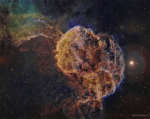
|
Astronomy Picture Of the Day (APOD)
 Medieval Astronomy from Melk Abbey
Medieval Astronomy from Melk Abbey
29.03.2024
Discovered by accident, this manuscript page provides graphical insight to astronomy in medieval times, before the Renaissance and the influence of Nicolaus Copernicus, Tycho de Brahe, Johannes Kepler, and Galileo. The intriguing page is from lecture notes on astronomy compiled by the monk Magister Wolfgang de Styria before the year 1490.
 Galileo s Europa
Galileo s Europa
28.03.2024
Looping through the Jovian system in the late 1990s, the Galileo spacecraft recorded stunning views of Europa and uncovered evidence that the moon's icy surface likely hides a deep, global ocean. Galileo...
 Millions of Stars in Omega Centauri
Millions of Stars in Omega Centauri
27.03.2024
Globular star cluster Omega Centauri, also known as NGC 5139, is 15,000 light-years away. The cluster is packed with about 10 million stars much older than the Sun within a volume about 150 light-years in diameter.
 APOD: 2024 March 27 Б The Coma Cluster of Galaxies
APOD: 2024 March 27 Б The Coma Cluster of Galaxies
26.03.2024
Almost every object in the featured photograph is a galaxy. The Coma Cluster of Galaxies pictured here is one of the densest clusters known - it contains thousands of galaxies. Each of these galaxies houses billions of stars - just as our own Milky Way Galaxy does.
 APOD: 2024 March 26 Б Comet Pons Brooks Ion Tail
APOD: 2024 March 26 Б Comet Pons Brooks Ion Tail
25.03.2024
Comet Pons-Brooks has quite a tail to tell. First discovered in 1385, this erupting dirty snowball loops back into our inner Solar System every 71 years and, this time, is starting to put on a show for deep camera exposures.
 APOD: 2024 March 25 Б Sonified: The Jellyfish Nebula Supernova Remnant
APOD: 2024 March 25 Б Sonified: The Jellyfish Nebula Supernova Remnant
24.03.2024
What does a supernova remnant sound like? Although sound is a compression wave in matter and does not carry into empty space, interpretive sound can help listeners appreciate and understand a visual image of a supernova remnant in a new way. Recently, the Jellyfish Nebula (IC 443) has been sonified quite creatively.
 APOD: 2024 March 24 Б Looking Back at an Eclipsed Earth
APOD: 2024 March 24 Б Looking Back at an Eclipsed Earth
23.03.2024
Here is what the Earth looks like during a solar eclipse. The shadow of the Moon can be seen darkening part of Earth. This shadow moved across the Earth at nearly 2000 kilometers per hour.
 Ares 3 Landing Site: The Martian Revisited
Ares 3 Landing Site: The Martian Revisited
22.03.2024
This close-up from the Mars Reconnaissance Orbiter's HiRISE camera shows weathered craters and windblown deposits in southern Acidalia Planitia. A striking shade of blue in standard HiRISE image colors, to the human eye the area would probably look grey or a little reddish.
 Phobos: Moon over Mars
Phobos: Moon over Mars
21.03.2024
A tiny moon with a scary name, Phobos emerges from behind the Red Planet in this timelapse sequence from the Earth-orbiting Hubble Space Telescope. Over 22 minutes the 13 separate exposures were captured near the 2016 closest approach of Mars to planet Earth. Martians have to look to the west to watch Phobos rise, though.
 The Leo Trio
The Leo Trio
20.03.2024
This popular group leaps into the early evening sky around the March equinox and the northern hemisphere spring. Famous as the Leo Triplet, the three magnificent galaxies found in the prominent constellation Leo gather here in one astronomical field of view.
|
January February March April May June July August September October November December |
|||||||||||||||||||||||||||||||||||||||||||||||||